![]()
![]()
![]()
Use LEFT and RIGHT arrow keys to navigate between flashcards;
Use UP and DOWN arrow keys to flip the card;
H to show hint;
A reads text to speech;
68 Cards in this Set
- Front
- Back
|
The Channel Framework |
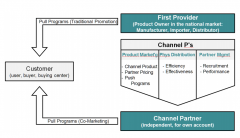
|
|
|
(Marketing) Channel definition |
A (marketing) channel is the entirety of organizations thatparticipate and support the process of shifting possession ofgoods from the producer to the end user. |
|
|
A marketing channel serves in particular to |
search potential users for the respective good(acquisitional component)---SALES bridge between production and consumption overspace and time (logistical component). ---SUPPLY CHAIN |
|
|
Channel Management Definitions |
Channel Design Channel Operations |
|
|
Channel Design |
Involves developing a channelstructure that links the SBU'sstrategy with the needs of thetarget market(s). Thesedecisions focus on how longthe channel should be andwhich types of institutions -and how many of each -should he included at eachlevel. |
|
|
Channel Operations |
The development of Policies &Procedures to gain & maintain thecooperation of the variousinstitutions in the organisation'sdistribution channels. Decisionsfocus on selecting and recruitingchannel members, motivatingthem to perform marketingactivities, coordinating efforts,assessing performance &resolving conflicts. |
|
|
Intermediaries Definitions |
Intermediaries are entities involved in the marketing channel of goods from themanufacturer to the ultimate consumer taking over functions which effect the transferof the rights of disposal or support the same. |
|
|
Reseller(take ownership of product) |
Wholesale selling to resellers or furtherprocessors Retail *) selling to private households *) In practice,very often the general term 'reseller' isused instead of retailer if he sells to bothconsumers and business users (for ownuse; mostly in SMB environments) |
|
|
Supporter(assist or influence the trade process) |
Assistants like financial partners, tradeinsurers, ext. sales forces,buying cooperation, Influencer like opinion leaders, industryexperts, press, consultants,tax advisors |
|
|
Where are the differences channel management has to handlecompared to "normal" marketing approaches? |
Differences in the organization (direct vs indirect) Differences in doing business with resellers |
|
|
Differences in the organization (direct vs indirect) |
Different sales approach than when selling direct Different organization Different sales competences |
|
|
Differences in doing business with resellers |
Different views on the same topic Different goals between producer and reseller Different customers to be addressed Different sources of power Different instruments ("the Ps") in an indirect environment |
|
|
Some of the differences in more detail |
We anticipate a mutual understandingbetween producer and resellers: "Let's increase profit together" This is the only similarity in the way of seeingthe business world. |
|
|
Mindset: Who takes over the secondary role – producer or reseller? |
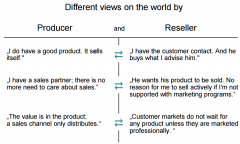
|
|
|
Costs:What is more expensive? Channel or direct sales? |
Producer: • I have to pay so much for channel distribution *).Shouldn't I better save the money and sell directly? Reseller: • I do the job that you are not capable to do *) Trade margins may be upup to 60%. And even more(very industry dependent). |
|
|
Costs: What is more expensive? Channel or direct sales? |
Clever producers understand the following: • The sales and logistics job has to be done (and paid)anyway. If you do it or the channel. • Producers lack financial resources to market directly. • Greater return for producers by focusing elsewhere. • The desired reach is not feasible through direct marketing. • We have to accept what the customer wants Somebody has to pay for all thesales efforts, regard-less if youdo it yourself (direct sales) orvia an intermediary (indirect sales). |
|
|
Misinterpretation: Equal can be very different |
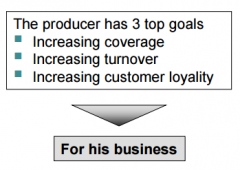
|
|
|
The different strategic goalsin the views of the involved parties |
Producer − Reaching all customers in (his) segment(s) − „Committed“ intermediaries (meaning, the own brand is No 1 out there) − Positioning and selling his brands actively − Producer marketing has to be implemented on the trade level Reseller − Broad offering (meaning, all relevant producers) − Little sales effort („Cash cows“, fast-selling items) − Independent marketing, financed by the producer − Minimal follow-up efforts (meaning, no returns due togood / acceptable product quality) |
|
|
The different operational goalsin the views of the involved parties |
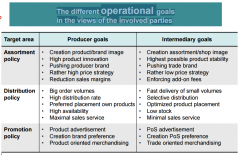
|
|
|
Basic question of each producer: Who is my customer? |
He who pays my invoices? He who has the customer access? He who buys my product? He who uses my product? To whom do I address my marketing? |
|
|
Marketing directions of a producer 1 |
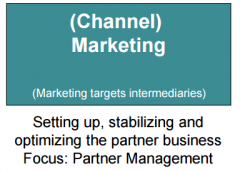
|
|
|
Marketing directions of a producer 2 |

|
|
|
Marketing directions of a producer 3 |
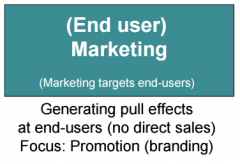
|
|
|
The different goals of producers and intermediaries Regardless of strategic or operational issues: Who enforces his claim? |
Understand your power position in the channel anddevelop your behavioral strategy. Adaption - you accept the given situationCooperation - you are looking for mutual agreementsConflict - you enforce your positionEvasion - you avoid channel conflics |
|
|
The different goals of producers and intermediaries |
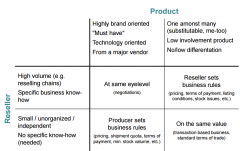
|
|
|
The different goals of producers and intermediaries Some typical situations The source of (channel) power is … |
the producers in case of • high brand orientation • "IN product" • technology orientation • small and unorganizedintermediaries e.g. automobile, prof. IT & Telco,luxury goods, high-tech andautomation products the resellers in case of • competing markets • commodity products • big and strong intermediaries e.g. food, household goods,audio/video, home IT, apparel,furniture, DIY |
|
|
PRODUCT: The reseller product Keep in mind: What is the reseller's offering? |
Shopping possibility − Availability of products − Fitting assortment according to customer needs − Spatial closeness to customer Add-on services − presales: consultancy − purchase: convenience, value add − aftersales: partnership The reseller chooses products that support best his offering.Not necessarily "the best", "the fastest", "the newest". |
|
|
PRODUCT: Channel interests |
Resellers are interested in − consistent assortment customer accepted in performance, quality − high turnover/margin given profitability − good brands or cheap clear positioning and promotion − no product return quality or throw away product − easy selling introduced product − easy handling packaging(no problem in exhibition, stock and transport) − no stock-keeping risk not yet at end of life Resellers are not interested in − the technical product 1) − introducing new products − slow movers − hard selling products (complex, new, unknown, bad designed, etc.) 1) exception: Value Added Reseller (VAR) |
|
|
PRODUCT: A package of different performance items |
Core product − Product competitive in functionality, quality, design, etc. − Good terms & conditions High trade margin, long payment terms, min. stock − Easy selling good brand, low-cost, introduced, high market share Add-on services − Presales reliable info, test products, pattern book, interactivewebsite (customer, closed reseller access) − Aftersales guarantee handling, tolerant returns, 7/24hotline, repair, customer events Supply chain − Easy handling ordering system, return mgmt, shelf mgmt − Fast delivery no/minimum stock needed − Special shipments drop-shippings, fixed date shipments, etc. |
|
|
Product design to attract resellers |
productsare unique & differentiatingor me-too and cheap ideal lifecycle Trade friendlypackaging - volume packages - easy to store |
|
|
Services to attract resellers
|
Take over hotline Take over repair service Produce resellermagazine Rack-jobbing Support with best info(e.g. closed intranet) |
|
|
PRICE: Compensation for channel partners |
Pricing in the channelis somewhatdifferent |
|
|
Price range (standard approach) |
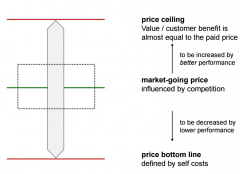
|
|
|
Price levels in channel practice |

Structure of price levels are found in all industries. Height ofdiscounts and profits are industry dependent. List price often set (too) high in order to grant significant discounts List price should not be touched (no operational instrument) RPP is typically calculated in % of the list price Operational pricing is done by timed discounts(idea: don't reduce the price, but give discounts ) |
|
|
The steering wheels for pricing: discounts, rebates, boni |
They are used as rewards for individual performances andcommitment of a retailer Discounts are front end price reductions: given at the time of purchase(seen on the invoice) Rebates/Boni are back end price reductions: given after completion ofthe purchase (calculated for a defined business period) Discounts and rebates are usually linked to specific conditions,boni are optional discount: e.g. time based, number of ordered units, certain trade functions rebate: e.g. total turnover in business year, specific assortment,loyalty, number of new customers, sold volume of a product bonus: e.g. credit note for stock problems, personal incentive |
|
|
Types of trade rebates in practice (overview) |
cooperation based trade based activity based |
|
|
cooperation based |
Partner category discounts Reseller discount Different for e.g. "platinum","gold" and "silver" partners Order based discounts Volume discount (per product) Single order discount Bundle discount Order volume discount Collective order discount Turnover based boni Yearly/quarterly rebate(based on achieved turnover) Turnover increase rebate Loyalty rebate Payment conditions Cash discount Delcredere refund Collection rebate Centralized settlement rebate |
|
|
trade based |
Compensation of trade functions Shelf rental Special placement rebate Listing feesNon-delisting rebate Secondary placement rebate Trial products (rebate or for free) Compensation for assortment Rebate for base assortment Rebate for special assortment Rebate for complete assortment Rebate for assortment expansion New product listing Entrance fee for first order New product rebate (Market) introduction rebate Opening of reseller sites Special services at (re)opening (Re)opening rebate (Re)opening promotion (specialproducts) |
|
|
activity based |
Functional rebates 'Sales'(sales promotion activities) Cooperative Marketing funds Market development funds Shop window rental Investment support Catalogue funds Advertising bonus Functional rebates 'Logistics' Rebates for logistical functions (stockkeeping, speed delivery, etc.) Wagon and truck rebate Pallets and box rebate Central warehouse rebate Self-collector rebate Functional rebates 'Services' Service cost compensation/rebate Complaints rebate Warranty rebate Product return rebate |
|
|
Special Case: Volume retailer |
Volume retailer = discounter type retailer − e.g.Media Markt – electronics (D)ALDI – food (D)Interdiscount – electronics (CH)Wal-Mart – full assortment (US)Carrefour – food (F)Tesco – full assortment (UK) |
|
|
„Marketing“: One idiom, different meanings |
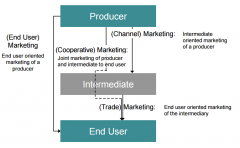
|
|
|
Try for a definition |
Managing upstream and down stream value added flow of materials,final goods and related information among suppliers, company,resellers, final consumers is supply chain management orphysical distribution. |
|
|
Supply chain management |
is a rather straightforward business in BtC environments (food &near food, low price & volume products) supply chain is a logistics issue stands for a value add in the sales channel in BtB environments(technology products, machine building, business supply) supply chain becomes a marketing issue |
|
|
Selected aspects to the supply chain |
Sales&Marketing and Logistics: in practice linked very closely Logistics as efficiency driver decrease costs Logistics as additional effectiveness increase value |
|
|
Quality criteria – external view ("the basics") |

|
|
|
Quality criteria – view of the reseller ("the added value") |
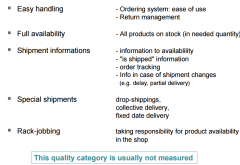
|
|
|
Quality criteria – internal view |
External requirements to be fulfilled (no subsequent corrections in the order handling) Process efficiency Inventory management − goods availability(No out-of-stock) − No overreach(reduced financial costs and depreciation) − High stock turnover(minimizes inventory risk) Limiting risk for accounts receivable(no/minimal bad debts) |
|
|
Basics of Partner (Relationsship) Management |
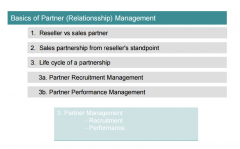
|
|
|
Reseller vs Sales Partner |

|
|
|
Reseller vs Sales PartnerThe difference |
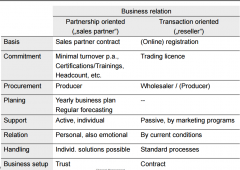
|
|
|
The different strategic goals in the views of the involved parties |
Producer • High coverage of (his) target group • „Committed“ intermediaries (meaning, the own brand is No 1 out there) • Positioning and selling his brands actively • Producer marketing has to be implemented on the trade level Retailer • Broad offering (meaning, all relevant producers) • Little sales effort („Cash cows“, fast-selling items) • Independent marketing, financed by the producer • Minimal follow-up efforts (meaning, no returns due to good productquality) |
|
|
Status reseller or sales partner |

|
|
|
The interest of a sales partner when picking a new supplier |
Goal: Economical attractivity of the „Business Proposition" Question: „Which suppliers contribute most to my business success withtheir business proposition and on which position is the newsupplier?“ Typical evaluation criteria: − turnover, margin, profit − costs (initial, on-going) − (additional) resources? − image value? − „easy selling“? − post-sales problems? |
|
|
Strategic decision for a sales partnership (1) |
Management Commitment (of the producer) − Has indirect sales a strategic relevance? − Is the organisation aligned for collaboration with the channel(resources)? − Is the commitment clearly communicated and is the actingaccordingly? Product offer − Is there a considerable need in my target group for theseproducts? − Are the products/services sell well (compared to competingproducts)? − Will products cause problems in the field (usage, functionalshortcomings, technical Channel Management defects, etc.)? |
|
|
Strategic decision for a sales partnership (2)View of the sales partner |
Sales Strategy − Am I competing with direct selling of the producer? − Am I competing with other sales partner of him? − Are my investments protected against others (Project protection,customer protection, finder‘s fee)? Sales Partner Program − Am I supported in my marketing by sales partner programs (comarketing,stock protection, project assistance, etc.)? − Is the performance in an attractive relation to my costs? − Will my performance be sufficiently refunded in case of success? |
|
|
Strategic decision for a sales partnership (3)View of the sales partner |
Collaboration − Are all necessary informations easy to get? − Are the respective partner manager clearly partner-oriented? − Is it easy to collaborate with the producer productively in practice(reliability, promptness, support, complexity, administrativequality, etc.)? Sustainability − Is the business model fit for the future? − Does the producer have the necessary funds and know-how tobe a winner in a competing market environment in the long term? − Is the producer above average in success compared to thecompetition? |
|
|
Different phases in the collaboration |
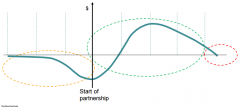
Analog to the product life cycle Classification in characteristic phases Different support needs (technical), product and service offers(sales), profit expectations |
|
|
Value contribution during the phases |

|
|
|
Reasons for Partner Recruitment |
Setting up a new sales channel(e.g. switch from direct to indirect sales) Setting up a complementary sales channel(e.g. adding a new product segment, focusing new target groups) Enlarging the existing partner base(e.g. potentials not utilized so far) Compensation of lost partner resources(e.g. termination of partner contract, partner closing down business) |
|
|
Balance between quality and quantity |
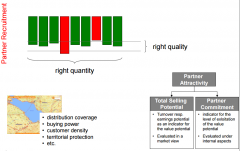
|
|
|
Process "Recruiting "the right" |
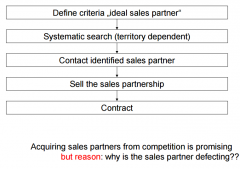
|
|
|
Partner Profiling - Criteria |
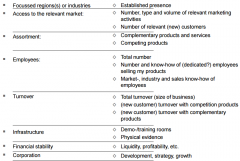
|
|
|
Partner performance: tying up sales partners |
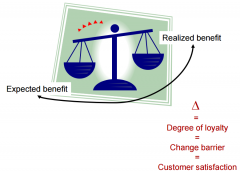
|
|
|
Causal relationships in the partner performance |
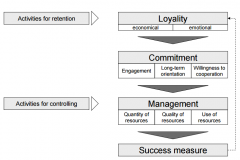
|
|
|
Tying up sales partners has two facets |
Business related Emotional / personal |
|
|
Business related |
Company strategic questions
Business benefit Economical aspects Legal criteria (see typical criteria for partner profiling) Partner loyality arises fromeconomical advantages andemotional effects |
|
|
Emotional / personal |
Income Appreciation Safety Satisfaction Working atmosphere Power Trust Less important forbig sales partners |
|
|
Economical and emotional relationship are connected |
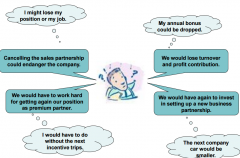
|

